I have Chronic Ear Disease, which basically just means I get a lot of ear infections. The repeated ear infections have damaged the delicate structure of my ears, resulting in me wearing purple hearing aids. Typically, the ear infections are annoying, but not super intrusive on my life. I might have to miss one class to run to St. Liam’s, get checked out by a doctor and pick up a prescription. Now, in the post-pandemic society, having a chronic illness is a bit more challenging. Doing things like going to the doctor can be quite challenging. Add this to the complexity of living in community with 200+ girls in a campus full of over 8,000 undergraduates. To keep myself from getting sick, I have been very careful to stay away from people and wear my mask. However, this past Monday I woke up with a sore throat and sticky ears, the calling signs of an ear infection for me. Last night, I determined that I should probably get checked out so I could get the necessary antibiotics. After consultation with a close friend, we determined that I would probably have to identify on the health check that I had a sore throat. Doing this the next morning led to me getting a yellow pass due to a sore throat being a potential COVID-19 symptom. I quickly called University Health Services (UHS) and let them know that yes, I had a sore throat, but it was most likely due to an ear infection as I had Chronic Ear Disease. After multiple phone calls, I had an appointment set up at 1 p.m. for me to come see them. Shortly afterwards, at 9:03 AM, I received a phone call from another doctor with UHS and I filled her in on everything. She said that I would have to arrive at the testing site by 9:20, and that I would have to be prepared to enter isolation if I tested positive. I was surprised, but thankfully had been expecting it. The previous night I had packed my bags per the advice of a friend who had been recently contact traced and quarantined. I grabbed my bags, looked around the room for anything else that I might need and ran out of the door juggling my load. I walked as fast as I could from Flaherty to the stadium to be tested, which was no minor feat when carrying a bag loaded with six textbooks and reading material. I was trying to sort out the situation in my head the entire way there. When I arrived at the testing site full of luggage, the workers automatically assumed that I was there for surveillance testing. As a result, I had to stand there to explain that I was there for the other test as my classmates walked by wondering what I was doing in line. I left my pile of bags behind, as I wandered into the stadium concourse to be given a rapid COVID-19 test and a strep test. The strep test was negative. As I awaited the results of the COVID-19 test, I was just thinking about how nice it would be to go back to my room, put the kettle on and curl up with a hot cup of tea while watching lecture. Instead, I was called up and told that yes it was negative, but I had to get a PCR test and go into isolation. I broke into tears. Here I was with an ear infection, limited in my communication abilities and with no clue what was happening as this was going in a very different direction than I had expected. I explained the situation to the nurse and, after consultation with UHS, it was determined that I would be required to go into isolation but would also receive a telehealth appointment during the afternoon. So, I trudged over to the testing table again to repeat the procedure for a PCR test. During the first test, I had chatted with the nurse about her day and life here on campus. The second test, it was all I could do to follow the steps of the procedure as I was bewildered by the circumstances. After the test, I was directed to sit in a row of seats to await transportation to isolation. A woman came up and briefly explained what was happening. I was told where I would be quarantining, informed that food would be delivered and directed to fill out a Google form on dietary preferences. Quickly thereafter, I found myself being guided to a golf cart, loaded onto it with my bags and driven away from campus. I looked out at campus as I pulled away, watching Our Lady through my water-filled eyes, wondering when I would get to see my Golden Dome again. Now, this situation, while unfortunate, was also predictable due to the University’s policies. The goal of the University is to keep its students and staff safe, and I posed a risk to this. But as someone who suffers from a chronic illness, I typically can describe exactly what will happen at a doctor’s visit prior to it. For that predictability to be taken away was not only puzzling, but also terrifying. Going forward, we can make the system more robust by not only sending the student for testing, but also establishing an appointment with UHS to ensure they are taken care of. If a student tests positive, they should have a consultation with a doctor. Similarly, if a student has symptoms but tests negative, they most likely have another health issue which also requires medical treatment. Another step that should be taken is that the student should be sent the procedure of the testing site prior to their arrival, so that they know what to expect. Additionally, policies need to be established for students with chronic illnesses to ensure that they do not end up in isolation for flare-ups of their illness. A solution to this would be creating an established relationship between those with chronic illnesses and the health officials on campus.Communication and information are one of the best ways to relieve stress and confusion and as such steps need to be taken in this direction.
Mia Hoffman
senior
Oct. 1













